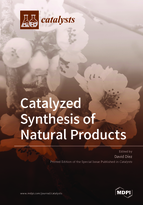Catalyzed Synthesis of Natural Products
A special issue of Catalysts (ISSN 2073-4344). This special issue belongs to the section "Catalytic Materials".
Deadline for manuscript submissions: closed (30 April 2018) | Viewed by 32579
Special Issue Editor
Interests: natural product transformations; organocatalysis; organic synthesis
Special Issues, Collections and Topics in MDPI journals
Special Issue Information
Dear Colleagues,
Natural products play pivotal roles not only in drug discovery, but in the transformation and synthesis of new material. The Organic Synthesis have been always next to natural products not only to corroborate their structure but too to obtain many derivatives in order to increase their activity and reduce secondary effects. In the last years, there has been a removed interest in doing the synthesis of natural products in a catalytic manner.This special issue collects original research papers, reviews and commentaries focused on the challenges for catalyzed synthesis of natural products. Submissions are welcome especially (but not exclusively) in the following areas:
Organocatalyzed synthesis of natural products;
Catalyzed synthesis of Natural Products with metals: this part could be divided into catalyzed by noble metals or first row metals;
Biocatalytic Synthesis of Natural Products: this part could be divided into using enzymes or using microorganisms.
Prof. Dr. David Díez
Guest Editor
Manuscript Submission Information
Manuscripts should be submitted online at www.mdpi.com by registering and logging in to this website. Once you are registered, click here to go to the submission form. Manuscripts can be submitted until the deadline. All submissions that pass pre-check are peer-reviewed. Accepted papers will be published continuously in the journal (as soon as accepted) and will be listed together on the special issue website. Research articles, review articles as well as short communications are invited. For planned papers, a title and short abstract (about 100 words) can be sent to the Editorial Office for announcement on this website.
Submitted manuscripts should not have been published previously, nor be under consideration for publication elsewhere (except conference proceedings papers). All manuscripts are thoroughly refereed through a single-blind peer-review process. A guide for authors and other relevant information for submission of manuscripts is available on the Instructions for Authors page. Catalysts is an international peer-reviewed open access monthly journal published by MDPI.
Please visit the Instructions for Authors page before submitting a manuscript. The Article Processing Charge (APC) for publication in this open access journal is 2700 CHF (Swiss Francs). Submitted papers should be well formatted and use good English. Authors may use MDPI's English editing service prior to publication or during author revisions.
Keywords
- synthesis
- catalysis
- natural products
- organocatalysis
- biocatalysis
- noble metals
- first row metals
- enzymes
- microorganisms






